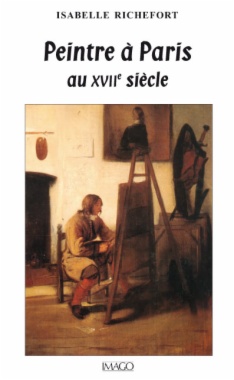Des artistes renommés — comme Poussin, Le Brun, Mignard — à ceux restés méconnus, Isabelle Richefort, après un important dépouillement d'archives, retrace tout d'abord la vie matérielle, culturelle et sociale des peintre dans le Paris des années 1600-1650. Quelle formation suivent-ils ? Où vivent-ils ? Qui fréquentent-ils ? Quel est leur degré de fortune ? Quelles sont leurs connaissances culturelles et leurs pratiques religieuses ? Puis, dans un second temps, l'auteur s'attache plus précisément aux œuvres. Pour qui peignent-ils ? Comment s'effectue le commerce de l'art ?
De l'|uvre profane à l'œuvre religieuse, de la très modeste « peinture en bâtiment » à la prestigieuse commande royale, nous suivons l'évolution de ce métier jusqu'à la création de la célèbre Académie royale — inspirée du modèle italien — qui reconnaît enfin en France l'art pictural comme une discipline de l'esprit.
Ancienne élève de l'école des Chartes, archiviste paléographe et docteur dès lettres, Isabelle Richefort est conservateur en chef du Patrimoine.
- Page de titre
- Sommaire
- REMERCIEMENTS
- Page de Copyright
- Introduction
- Première Partie - LE PEINTRE
- Chapitre I - LA FORMATION DU PEINTRE
- I. L’ORIGINE GÉOGRAPHIQUE ET SOCIALE DES APPRENTIS PARISIENS
- II. L’APPRENTISSAGE ET LES TECHNIQUES A MAITRISER
- III. LE COMPAGNONNAGE
- IV. L’ACCÈS À LA MAÎTRISE
- V. LES VOYAGES À L’ÉTRANGER
- NOTES
- Chapitre II - LA VIE MATÉRIELLE
- I. LES QUARTIERS DES PEINTRES
- II. LE LOGEMENT DES PEINTRES
- III. MOBILIER, DÉCOR, OBJETS PRÉCIEUX
- IV. LA FORTUNE DES PEINTRES
- NOTES
- Chapitre III - LA VIE CULTURELLE ET SOCIALE
- I. LES ALLIANCES ET LES FRÉQUENTATIONS DES PEINTRES
- II. LA CULTURE DES PEINTRES
- III. PRATIQUE ET SENTIMENTS RELIGIEUX
- NOTES
- Deuxième Partie - LES ŒUVRES
- Chapitre I - LA DÉCORATION PROFANE
- I. LES GRANDES ENTREPRISES
- II. DES DÉCORATIONS PEINTES PLUS MODESTES
- NOTES
- Chapitre II - LA DÉCORATION RELIGIEUSE
- I. LES DÉCORATIONS PEINTES
- II. LES COMMANDES DE TABLEAUX
- III. LES TRAVAUX DÉCORATIFS MINEURS
- NOTES
- Chapitre III - LES TABLEAUX DE CABINET LA TAPISSERIE, LA GRAVURE
- I. LES COMMANDES DE TABLEAUX
- II. LES CARTONS DE TAPISSERIE
- III. LA GRAVURE
- NOTES
- Chapitre IV - LE COMMERCE DES TABLEAUX
- I. LA VENTE DES ŒUVRES
- II. EXPERTS ET MARCHANDS
- III. RESTAURATION DE PEINTURES ET ACTIVITES DIVERSES
- NOTES
- Troisième Partie - VERS LA CRÉATION DE L’ACADÉMIE DE PEINTURE ET DE SCULPTURE
- Chapitre I - L’OPPOSITION ENTRE LES PEINTRES DU ROI ET LA MAITRISE
- I. LE CADRE DE L’EXERCICE DU MÉTIER AU DÉBUT DU XVIIe SIÈCLE
- II. LA RÉACTION DE LA CORPORATION PARISIENNE
- III. LE MODÈLE ITALIEN DES ACADÉMIES DE PEINTURE
- IV. PEINTURE ET POÉSIE
- V. UN MÉTIER DOMINÉ PAR VOUET ET LE BRUN
- NOTES
- Chapitre II - LA CRÉATION DE L’ACADÉMIE
- I. LA MAÎTRISE REPREND L’OFFENSIVE
- II. LA CRÉATION DE L’ACADÉMIE ROYALE DE PEINTURE ET DE SCULPTURE
- III. SITUATION DU MÉTIER AU DÉBUT DU RÈGNE DE LOUIS XIV
- NOTES
- Conclusion
- SOURCES
- BIBLIOGRAPHIE
- EXPOSITIONS

